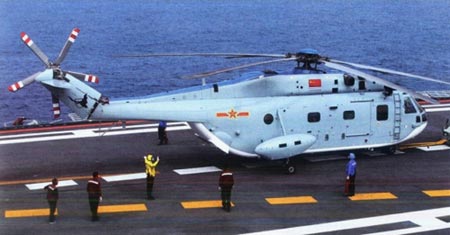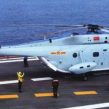
China Plays Helo Card to Shift Military Balance in East China Sea Dispute
Publication: China Brief Volume: 15 Issue: 5
By:

Despite a slight improvement in Sino-Japanese relations since Japanese Prime Minister Shinzo Abe visited Beijing in November 2014 for the Asia Pacific Economic Cooperation (APEC) summit, both countries have diligently enhanced their military and support capabilities in the vicinity of the disputed Senkaku/Diaoyu Islands during the past year. The People’s Liberation Army (PLA) appears to be developing a future strategy for maintaining a patrol and surveillance presence around the Islands that would rely heavily on helicopters currently in development, namely the Z-18 and Z-20. This article will first explain the new facilities China is building around the Islands and then discuss the new helicopters that will likely be deployed to the East China Sea once they successfully complete testing over the next several years, and how this may affect the military balance in the East China Sea.
Maritime Trench Warfare? China and Japan Line Up in the East China Sea
China has significantly upgraded its military facilities on Nanji Island, one of its numerous coastal islands. Nanji’s position is significant. As illustrated by the map below, it is close to both the northern end of China’s patrol line with Taiwan, the commercial hub at the mouth of the Yangzte River and a bare stone’s throw from the Senkaku/Diaoyu Islands (Global Times, December 22, 2014). At the same time, Japan is also fortifying islands in the area, in what looks to be a gradual reinforcement of surveillance and power projection capabilities in their most hotly disputed area.
Comparisons of images from August 2013 and December 2014 show dramatic changes. A hill has been flattened to make room for ten helipads. An advanced radar was already positioned on Nanji Island. The addition of the helipads creates a “forward presence” for Chinese helicopters to conduct surveillance and Anti-Submarine Warfare (ASW) patrols. In terms of naval surveillance, Nanji occupies important “near-seas” real-estate. Upgraded Chinese helicopters, such as the ASW variant of the Z-18 tested last year, would be well positioned to monitor traffic through complex maritime environments like the Taiwan Strait (Sina Mil, April 30, 2014). Most importantly however, is the potential for basing a quick reaction force on Nanji. The Z-8, currently the PLA’s workhorse heavy lift helo, is capable of carrying twenty-seven fully equipped soldiers. Assuming at least two WZ-9s light attack helos or similar for air support, China could quickly deploy over 200 soldiers to the Senkaku/Diaoyus. This mirrors Japan’s current plans for the creation of an amphibious response force (Asahi Shimbun, May 23, 2014). Defense Ministry Spokesperson Hua Chunying has insisted that the installation is not directed at Taiwan, which taken at face value would suggest that they are instead directed at Japan (Global Times, January 29). Other additions to the island include a string of wind turbines on its east side to help power the new installation. These improvements to Nanji are much more about enhancing China’s monitoring of its littorals and power projection near the Senkaku/Diaoyus–not its green energy program.
Nanji is only the latest island to receive upgrades. Elsewhere, to cement control over disputed areas, China has followed a program that begins with increased aerial and maritime intrusions, followed by a period of reinforcement of monitoring capabilities (including the deployment of drones), which is then followed by the construction of infrastructure to reinforce those claims (see China Brief, November 7, 2013). Improvements to other islands (or the expansion of islets) such as Woody Island in the South China Sea, follow this pattern (see China Brief, October 23, 2014). China’s goal is “strategic management of the sea” (jinglue haiyang): establishing administrative control and monitoring of its territorial claims through a variety of means, including better weapon systems and bases (see China Brief, January 9). Showing up is often the best indicator of sovereignty, and increasing Chinese presence (and military power projection) in disputed or near disputed areas has proven an effective tool in solidifying Chinese claims. China’s neighbors are responding in kind.
Opposite Nanji, the Japanese Self Defense Force (JSDF) has also been busy. Japan’s acquisition of new maritime surveillance planes and several Global Hawk surveillance drones—with sufficient range to fly from their base in northern Japan and loiter in the Miyako–Senkaku/Diaoyu area—are only two of several efforts by Japan to increase its ability to monitor China’s activities in the East China Sea and beyond (see China Brief, February 2). The Japanese deployment of a coastal observation unit to Yonaguni Island offers a significant boost to the JSDF’s maritime monitoring capability (Yomiuri, February 23; CCTV, February 22). Yonaguni’s proximity to the Senkakus, as illustrated above, provides more detailed monitoring of oceanic traffic than periodic patrols from Naha Air Base on Okinawa would. China’s declared Air Defense Identification Zone (ADIZ) overlaps significantly with Japanese airspace (see the darker shaded area on the above map). It is therefore possible that improved monitoring of aircraft entering Japan’s airspace is another possible benefit, particularly given the rising number of scrambles the Japanese Air SDF responds to. This number of intercepts of Chinese aircraft continues to rise, with 371 intercepts reported between April 1st and December 31st of 2014—an average of 1.3 per day (JMOD, February 12).
In case of conflict, Yonaguni is a useful position from which to threaten Chinese ships. The JSDF’s Type 12 Surface to Ship missile has a range of 100 kilometers (USNI, June 18, 2014). If deployed to Yonaguni or the Miyako Islands, this would be sufficient to cover a large area around the Senkaku/Diaoyus. It would also allow power projection within the Miyako Strait, with batteries on the southwest and northeast sides of the strait able to cover approximately two-thirds of the Strait, China’s primary exit to the Western Pacific (Sina Military, August 13, 2014). If China follows a similar course as Nanji for its other outlying islands, Japan and China will be facing off over the walls of a line of “sea forts” bristling with advanced weapons. Improving Chinese transport helicopters, however, may have a disruptive influence.
“Riding Donkeys to Find Horses”? China’s New Transport Helicopters Show Progress
New photographs and CCTV video reveal two types of Chinese transport helicopter undergoing tests. Both aircraft have familiar profiles; they are improved variants of helicopters already in the PLA’s inventory of weapons. Their introduction, however, will help close two significant gaps in PLA transport needs: high altitude and medium-weight helicopters.
The Z-18, which recently underwent high altitude testing in Tibet, is an upgraded Z-8, itself derived from the French Super Frelon helicopter (ChinaMil, January 15). The Z-20 is derived from the UH-60 Black Hawk, a ubiquitous transport helo used by the United States and its allies that was sold in small quantities to China during the early 1980s. China’s Black Hawks are the remainder of a largely forgotten period in the early 1980s when the United States sold weapons to China and even established joint electronic surveillance posts inside China—an unthinkable situation today. [1]
|
Comparison Chart: China’s Transport Helicopters |
|||||
|
|
UH-60 |
Z-9A |
Z-8 |
Z-18 |
Z-20 (est) |
|
Weight |
4,819kg |
2,050kg |
6,980kg |
~8,000kg |
>5,000kg |
|
Length |
19.76m |
12.11m |
23m |
23m |
20m |
|
Capacity (internal) |
1,200kg |
1,900kg |
3,000kg |
>5,000kg |
>5,000kg |
|
Combat Radius |
590km |
>500km |
500km |
>500km |
<450km |
The Z-20 first flew in December 2013 and early estimates predicted deployment sometime in 2015 (Sina Military, December 23, 2013). While, like the Black Hawk, it is intended to be a multi-role transporter, it likely does not face the same sorts of design constraints as its U.S. progenitor, such as the need to be air-transportable. Chinese media notes that the Z-20 will not be a straight copy of the 1980s-era UH-60s, having benefited from China’s own progress in avionics and materials science (Air Force World, November 23, 2014). Indigenous production also removes an element of uncertainty and hesitance that has slowed Sino-Russian arms transfers.
China’s military needs the capabilities the Z-18 and Z-20 will provide. The Z-20 is guaranteed to see wide deployment throughout China and the various services. Though possessing sufficient numbers of Z-9 light multi-role helos, the Z-20 is needed to fill a hole in the PLA’s inventory currently occupied by variants of the Russian Mi-8/Mi-171 and China’s small number of remaining Black Hawks. The Z-20’s flexibility and size means that it is light enough to serve aboard ships, and has powerful enough engines to be able to operate at high altitudes. This capability meant that China’s original UH-60s were in high demand during the 2008 Sichuan Earthquake disaster response.
The Z-18’s high altitude capability has an important role to play in China’s remote areas, particularly Tibet. Other than China’s few remaining Black Hawks, the Z-18 will be China’s sole high altitude capable helicopter the Z-20 is deployed (CCTV, February 2). Even then, its heavy lift capacity will allow China to move artillery and troops much faster. As mentioned earlier, the Z-20 and Z-18 will have important maritime surveillance and anti-submarine warfare roles to play on China’s coast and on island bases throughout China’s territorial claims.
China’s current inventory of large ASW helicopters, including the new Z-18, are too heavy to operate off of small warships (Jane’s, August 20, 2014). Lacking an effective middle-weight multi-role helicopter capable of carrying large loads and landing on ships has limited the range and capability of naval aviation assets (see China Brief, April 12, 2013). Less than ten tons, the Z-20 can be carried on all of China’s “air-capable frigate destroyers, amphibious assault ship or aircraft carrier” (China Daily, January 3, 2014). If deployed from an amphibious assault ship, it would be able to more effectively move large number of troops and equipment to shore than the smaller Z-9. Larger capacity would also mean more effective sensors and weapons, giving Chinese ships a greater margin of safety against the threat of submarines. Limited to only the heaviest classes of ships, the Z-18 would likely benefit from semi-permanent basing on island bases such as Nanji or Yongxing islands, where its weight would not be an issue, but its longer “legs” and lifting power would allow it to carry more sophisticated sensors and bigger weapons payload (see China Brief, October 23, 2014; Sina Military, February 9).
Conclusion
After several decades using Soviet-era and civilian-derived “donkeys” for its transport needs, China is finally acquiring the modernized “horses” it needs to effectively transport its military personnel and equipment. When deployed, the PLA’s Z-18 and Z-20 will play an important role in supporting Chinese efforts to press its territorial claims and prepare a response force for contingencies in the East China Sea. As China finishes construction of the base on Nanji Island, its intentions will become clearer. Facilities for a large troop element would indicate a credible ability to take territory in the Diaoyu/Senkakus. Deployment of Z-18s equipped with ASW sensors and weapons would certainly make intrusions by JMSF or Taiwanese submarines into the area much more difficult. This forward base will give the PLA much more flexibility and could provide forward-deployed supplies for Chinese units conducting operations near or on the Diaoyu/Senkakus. It remains to be seen whether Japan chooses to make a counter-move, such as expanding the planned observation unit on Yonaguni to a full rapid-response force, or expanding its anti-air coverage of the area. In either case, the danger for further escalation will be higher than ever—and ultimately will have an impact on Sino–Japanese relations.
Notes
- The United States sold China 24 Blackhawks between 1984–85. According to IISS, 19 remain active (IISS, The Military Balance 2014, p. 233).





